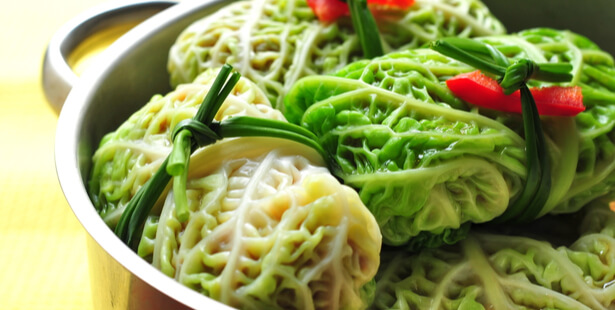Cabbage is the victim of many prejudices: it is difficult to digest and its taste leaves something to be desired. And yet, beneath their thicknesses to be stripped, treasures of flavors and nutrients are hidden.
Unloved, unrecognized, mistreated, cabbages resist! To bad words, and to the evils of winter. They have what they need to defend themselves: physically thanks to their multi-layers, and internally thanks to their rather exceptional nutritional qualities. Shelling.
At the heart of cabbages and their nutritional benefits
Cabbages are part of the cruciferous family. And there are many of them: cauliflower, green cabbage, Brussels sprouts, kale, broccoli, red cabbage, Chinese cabbage…
They jostle on the merchants’ stalls and create pretty paintings shaded with green, smooth or grainy, round like balloons, or in the form of shrubs. They are beautiful to look at… and good to eat! To make the most of the benefits of cabbage, you can eat it raw or cooked. Properly prepared, cabbage is not difficult to digest. Rich in fiber, vitamins, minerals and antioxidants, particularly sulfur, cabbage is a valuable health ally.
Cabbage is the oldest vegetable in the garden © Xizmena
Certain nutritional benefits
Cabbage is the victim of many prejudices: it is difficult to digest and its taste leaves something to be desired. And yet, beneath their thicknesses to be stripped, treasures of flavors and nutrients are hidden.
Cabbages are sources of:
- vitamin Cantioxidant, anti-infectious
- fibersto regulate the intestines
- vitamine B9against anemia
- vitamins E for muscles and nerves of steel
- vitamine Kantihemorrhagic
- vitamines B (B1, B2, B3, B5, B6)
- provitamin Afor good vision and beautiful skin
- calciumto strengthen bones
- potassium for good regulation of body water and good nerve impulses
They are very low in calories, because they are rich in water (from 20 kcal/100 g to 41 kcal/100g for Brussels sprouts).
200 g of cabbage covers: 40 to 50% of the daily vitamin C needs, 20% of the fiber needs, 1/4 of the vitamin B9 needs.
Cabbages – did you know
Cabbage has long been associated with fertility. In ancient Greece it was served as soup to newlyweds on the morning of their wedding night. It is this ancient practice which is at the origin of the legend which claims that children are born in cabbages.

Cabbage provides excellent nutrients for children © Ivan Galashchuk
The anti-cancer properties of cabbage
Cabbages also have other benefits: substances such as indoles, isothiocyanates and dithiolthiones seem to have powerful anti-cancer effects(1).
Numerous experiments carried out over the past twenty years, both on animals and in humans, confirm the beneficial action of regular consumption of cabbage in the cancer prevention colon and stomach, but also lung cancer, esophagus…
Cabbages love weddings
In the kitchen, he is insatiable and chooses his partners in all categories:
- THE sweet and sour preparations ;
- THE fruits : apple, fresh or dried grapes, nuts;
- THE other vegetables : carrot, celery, beetroot;
- Also cheese, garlic croutons, juniper berries, meat, poultry and even fish.
Organic cabbage recipes
Red cabbage with orange and pistachios
The hotpot: Auvergne or Lorraine
Raw cauliflower couscous

Small stuffed green cabbages © Kostiantyn Ablazov
Some flaws in the cabbage though…
The sulfur blows hot and cold in the cabbages. If he gives a characteristic flavor – which may displease – the cruciferous family, it also plays a role of pollutant cleaner by promoting the elimination of toxic substances present in food and which are factors of aging.
Sulfur, associated with fiber, sometimes causes intestinal intolerances when cooked. Then simply blanch the cabbage. And for those who are sensitive to its taste, they can add a few seeds of cumin or green anise to the cooking water.
Cabbage’s favorite: sauerkraut
The dietician’s opinion : It’s a food that we can no longer dietary, delicious, calorie-freebut with a number of benefits impressive.
Sauerkraut has a rate of fibers twice as high (4.4 g/100 g) as other cabbages: it therefore gently regulates the intestines and has a satietogenic power important. Sulfur issues are resolved since the cabbage is fermented.
Fermentation also has another advantage: it develops probioticsthese “friendly” bacteria for the intestinal flora which help strengthen the immune system.

Fermented sauerkraut plain and flavored with beetroot in jars © Elena Hramova
Advantage in the kitchen : Sauerkraut does not need to be cooked to be cooked. It can be enjoyed cold, in a salad, or hot. With traditional sausages (which provide the calories), or with fatty fish like salmon or mackerel: the tangy acidity of sauerkraut goes wonderfully well with these fish.
consoGlobe also recommends…
Source: www.consoglobe.com


